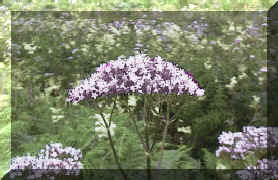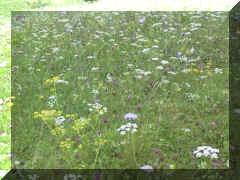Species Datapage No 34
You may click on most photographs to enlarge. *Denotes a Naturalised species
Scroll down to find a species
|
Species Datapage No 34 |
|
You may click on most photographs to enlarge. *Denotes a Naturalised species |
|
Scroll down to find a species |
| Species Common Name: Valerian or Wild Valerian | |||||||||||||
| Species Botanical Name: Valerian officinalis | |||||||||||||
| A plant typical of the banks and meadows of the River Shannon | |||||||||||||
 Wild
Valerian is a very important medicinal plant. In Ireland this
plant is becoming scarce as it's habitats disappear. Wild
Valerian is a very important medicinal plant. In Ireland this
plant is becoming scarce as it's habitats disappear.
We find this plant very difficult to germinate from seed, When it does germinate the roots of the plant tend to be frost tender and have specialised in the way that it attaches to the ground, in that the crown stays above the soil in wet land where it floods. |
|||||||||||||
| Management:
In meadows keep the soil wet, block up your drains and allow an
amount of thatch to develop to provide protection to the root zone of
the plant. Winter flooding also helps protect against the
frost. The plant is not frost tender in Horticulture as it is
ground to have its roots below soil level.
Whatever, never destroy a meadow where this plant is found naturally. Seek advice from your local wildlife advisor or contact us. |
|||||||||||||
| Valerian is also found in open damp wood, and is a very useful species in such situations as little else flowers at the end of summer in wet woods. | |||||||||||||
| Tolerance of cutting: Low, | |||||||||||||
| Cutting time: Spring, | |||||||||||||
| Edible / Medicinal: , Medicinal, | |||||||||||||
|
Life Cycle (Form): Annual, Biennial, Perennial Flower Height: 50 to 125 cm Foliage Height: 25 - 40 cm Flower Colour: Pinkish - White, Pink Flowering period: July, August, Time to Flower: 24 months Soil Type: Will grow in damp rich soils. pH Type: Acid, Neutral, Alkaline. Moisture: Moist, Wet Aspect: Full sun, Damp open woods Wildlife Value: High, Attracts Butterflies, Bees, Hoverflies and Insects. |
|||||||||||||
|
|||||||||||||
| Species Common Name: *Wild Parsnip | |||||||||||||
| Species Botanical Name: Pastinaca sativa | |||||||||||||
 Sorry no
'close up' photograph. The photo shows a meadow in the Ballast Field,
Athlone, where for years this plant grew until the site was filled in. Wild
parsnip is the yellow flower in the foreground. Sorry no
'close up' photograph. The photo shows a meadow in the Ballast Field,
Athlone, where for years this plant grew until the site was filled in. Wild
parsnip is the yellow flower in the foreground.
This plant will be well behaved where it grows in grassland, on its own it reaches for the sky and becomes far to tall, unless you want a stunning tall yellow flower. |
|||||||||||||
| Management: Allow
to set seed.
Note: The hollow stems of this plant will over winter many insect species. Do not cut all of a meadow where this plant survives, cut the largest clump in spring. |
|||||||||||||
| Tolerance of cutting: Low, | |||||||||||||
| Cutting time: Spring, Autumn. | |||||||||||||
| Edible / Medicinal: Edible ancestor. | |||||||||||||
|
Life Cycle (Form): Biennial, Flower Height: 60 to 200 cm Foliage Height: 25 - 60 cm Flower Colour: Yellow, Flowering period: July, August, Time to Flower: 12, months Soil Type: Will grow in most dry soils. pH Type: Acid, Neutral, Alkaline. Moisture: Dry, Aspect: Full sun, Wildlife Value: High, Attracts Hoverflies and Insects. |
|||||||||||||
|
|
|||||||||||||